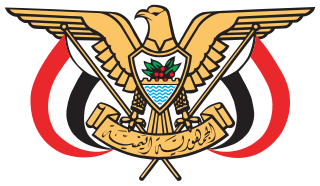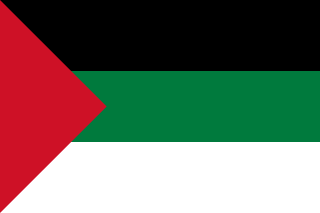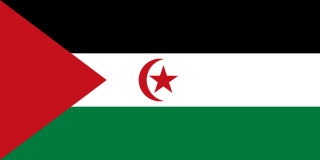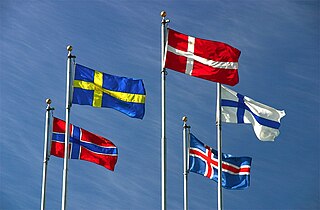
A flag is a piece of fabric with a distinctive design and colours. It is used as a symbol, a signalling device, or for decoration. The term flag is also used to refer to the graphic design employed, and flags have evolved into a general tool for rudimentary signalling and identification, especially in environments where communication is challenging. Many flags fall into groups of similar designs called flag families. The study of flags is known as "vexillology" from the Latin vexillum, meaning "flag" or "banner".

A national flag is a flag that represents and symbolizes a given nation. It is flown by the government of that nation, but can also be flown by its citizens. A national flag is typically designed with specific meanings for its colours and symbols, which may also be used separately from the flag as a symbol of the nation. The design of a national flag is sometimes altered after the occurrence of important historical events. The burning or destruction of a national flag is a greatly symbolic act.

The flag of Iraq is the national flag of Iraq, includes the three equal horizontal red, white, and black stripes of the Arab Liberation flag, with the takbir written in green in the Kufic script in the centre.

The national flag of Chad is a vertical tricolour consisting of a blue, a gold and a red field. Since the 1990s, its similarity to the flag of Romania has caused international discussion.

The State flag of Yemen was adopted on May 22, 1990, the day that North Yemen and South Yemen were unified. The flag of Yemen is the Arab Liberation Flag of 1952, introduced after the Egyptian Revolution of 1952 in which Arab nationalism was a dominant theme. The Arab Liberation Flag of 1952 served as the inspiration for the flags of both North and South Yemen prior to unification, as well as for the current flags of Egypt, Iraq, Sudan, Palestine and Syria.

The national emblem of Yemen depicts a golden eagle of Saladin with a scroll between its claws. On the scroll is written the name of the country in Arabic: الجمهورية اليمنية or Al-Jumhuriyyah Al-Yamaniyah. The chest of the eagle contains a shield that depicts a coffee plant and the Marib Dam, with seven blue wavy stripes below. The flagstaffs on the right and left of the eagle hold the flag of Yemen.

The national flag of Egypt is a tricolour consisting of the three equal horizontal red, white, and black bands of the Egyptian revolutionary flag that dates back to the 1952 Egyptian Revolution. The flag bears Egypt's national emblem, the Egyptian eagle of Saladin, centred in the white band.

The current flag of Sudan was adopted on 20 May 1970 and consists of a horizontal red-white-black tricolour with a green triangle at the hoist. The flag is based on the Arab Liberation Flag of the Egyptian Revolution of 1952, as are the flags of Egypt, Iraq, Syria, Yemen, and Palestine and formerly of the United Arab Republic, North Yemen, South Yemen, and the Libyan Arab Republic.
As a result of the Syrian Civil War since 2011, there are at least two flags used to represent Syria, used by different factions in the war. The incumbent government of the Syrian Arab Republic led by the Ba'ath Party uses the red-white-black tricolour originally used by the United Arab Republic, while Syrian opposition factions such as the Syrian National Coalition use the green-white-black tricolour known as the ''Independence flag'', first used by Mandatory Syria.

The flag of the United Arab Emirates contains the Pan-Arab colors red, green, white, and black. It was designed in 1971 by Abdullah Mohammed Al Maainah, who was 19 years old at that time, and was adopted on 2 December 1971 after winning a nationwide flag design contest. The main theme of the flag's four colors is the sovereignty and unity of the Arab states.

The pan-Arab colors are black, white, green and red. Individually, each of the four pan-Arab colors were intended to represent a certain aspect of the Arab people and their history.

The coat of arms of Egypt is known as the Republican Eagle or Egyptian Golden Eagle, is a heraldic golden eagle, facing the viewer's left (dexter). The eagle's breast is charged with an escutcheon bearing the red-white-black bands of the flag of Egypt rotated vertically, whilst the eagle's talons hold a scroll bearing the official name of the state written in Kufic script. The earliest version of the Eagle of Saladin was that used as the flag of Saladin, the first Sultan of Egypt, whilst the modern version of the eagle was adopted during the Egyptian Revolution of 1952. Subsequently, the modern design of the eagle of Saladin was adopted as the coat of arms of numerous other states in the Arab World, such as the United Arab Republic, North Yemen, Iraq, South Yemen, the Libyan Arab Republic, and Palestine. The current eagle was modified in 1984 to its present form.

The Aden Protectorate was a British protectorate in southern Arabia. The protectorate evolved in the hinterland of the port of Aden and in the Hadhramaut after the conquest of Aden by the Bombay Presidency of British India in January 1839, and which continued until the 1960s. In 1940, it was divided for administrative purposes into the Western Protectorate and the Eastern Protectorate. The territory now forms part of the Republic of Yemen.

The current national emblem of Sudan was adopted in 1985.

The flag of Western Sahara, also known as the flag of the Sahrawi Arab Democratic Republic, uses a national flag consisting of a black, white and green horizontal tricolor charged with a red star and crescent in the center stripe and a red chevron at the hoist. It is used on SADR-controlled areas, while the Moroccan flag is used on the occupied parts of Western Sahara.

An Islamic flag is the flag either representing an Islamic Caliphate, religious order, state, civil society, military force or other entity associated with Islam. Islamic flags have a distinct history due to the Islamic prescription on aniconism, making particular colours, inscriptions or symbols such as crescent-and-star popular choices. Since the time of the Islamic prophet Muhammad, flags with certain colours were associated with Islam according to the traditions. Since then, historical Caliphates, modern nation states, certain denominations as well as religious movements have adopted flags to symbolize their Islamic identity.

The flag of the Arab Revolt, also known as the flag of Hejaz, was a flag used by Hussein bin Ali and his allies, the Arab nationalists, during the Arab Revolt against the Ottoman Empire during World War I, and as the first flag of the Kingdom of Hejaz. It was designed by Mark Sykes but is highly reminiscent of previous Arab flags, such as the flags of the al-Muntada al-Adabi, al-ʽAhd and al-Fatat.

Military aircraft insignia are insignia applied to military aircraft to visually identify the nation or branch of military service to which the aircraft belong. Many insignia are in the form of a circular roundel or modified roundel; other shapes such as stars, crosses, squares, or triangles are also used. Insignia are often displayed on the sides of the fuselage, the upper and lower surfaces of the wings, as well as on the fin or rudder of an aircraft, although considerable variation can be found amongst different air arms and within specific air arms over time.

The flag of Yugoslavia was the official flag of the Yugoslav state from 1918 to 1992. The flag's design and symbolism are derived from the Pan-Slavic movement, which ultimately led to the unification of the South Slavs and the creation of a united south-Slavic state in 1918.

Flag families are sets of national flags with similarities in their design, often based on a shared history, culture, or influence. Families do not include flags with coincidental similarities. Flags may be in multiple flag families. Only twelve current national flags existed before the 19th century, when large-scale flag use began. Seven of these flags are the inspiration for more than 130 current national flags and ensigns.
























